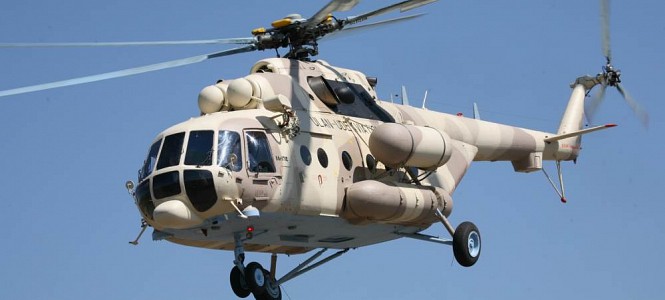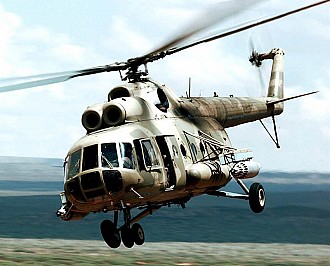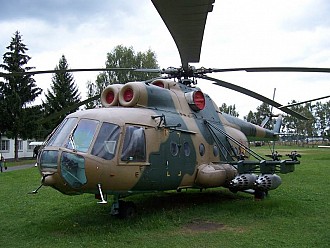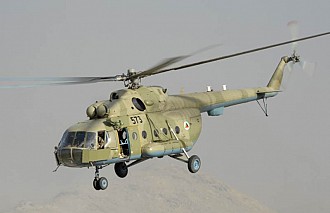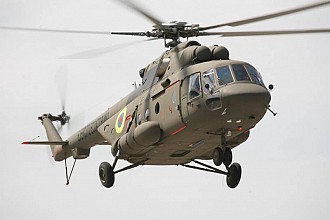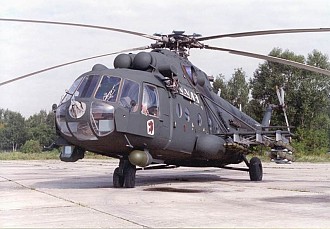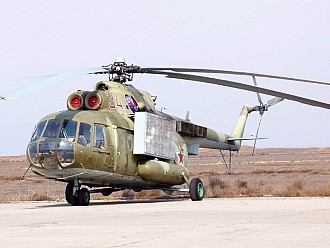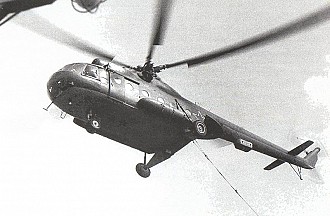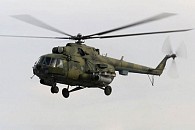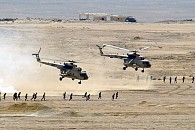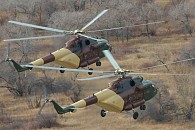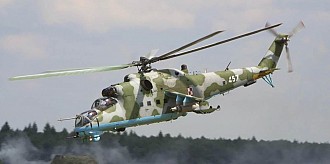Aircraft / Utility helicopters / Mi-8 Hip
Mi-8 Hip
General Facts
- TYPE
Transport helicopter - ORIGIN
 USSR
USSR - NICKNAMES
Hip (NATO reporting name) - DESIGNED
1960 - 1965 - DESIGNER
Mil - PRODUCTION
1967 - present (USSR/Russia)
2008 - present (China) - PRODUCERS
 China - Sichuan Lantian Helicopter Company
China - Sichuan Lantian Helicopter Company
 Russia - Kazan
Russia - Kazan
 Russia - Mil (Ulan Ude)
Russia - Mil (Ulan Ude)
 USSR - Mil
USSR - Mil - QUANTITY
Over 17.000 including civilian sales - UNIT COST
$ 3.5 to 4.5 million for Mi-171 in 2002 - CHARACTERISTICS
 Good payload capacity
Good payload capacity
 Large weapons load
Large weapons load
 Good speed and range
Good speed and range
 Lacks armor for gunship role
Lacks armor for gunship role
Introduction
The Mi-8 is a transport helicopter of Soviet origin. It was developed in the early 1960's to provide Soviet forces with a larger capacity helicopter than the Mi-4 and more maneuverable and practical than the Mi-6. The commonly used NATO reporting name is Hip. The Mi-8 and the second generation Mi-17 are some of the most numerous and widely exported helicopters ever built. Besides its troop transport role it can be used as an attack helicopter due to its significant weapon load.
Layout
The Mi-8 has the same general layout as the earlier and much large Mi-6, but does not share any components. The Mi-8 has a side by side cockpit that is followed by a large cabin with a door in the left and large clam shell doors at the rear. Two turboshafts on top of the cabin power the large five blade main rotor. The first generation Mi-8 was followed by the improved Mi-17, which is called Mi-8MT in Soviet service. The Mi-17 features more powerful engines and various other improvements. From both versions a wide range of variants have been developed, including dedicated assault versions with additional armor and weapon options.
Firepower
Originally the Mi-8 featured optional racks for four UV-16 rocket pods for a total of 64 S-5 rockets. Shortly thereafter larger racks for six UV-32 pods were introduced, allowing for a staggering 192 S-5 rockets. Later models such as the Mi-17 are often fitted with four pods for 20 of the more effective S-8 rockets. It is also possible to fit gun pods or free fall bombs, although this is not common practice. Dedicated attack version feature the ability to launch guided anti-tank missiles and some have a 12.7mm heavy machine gun mounted in the cockpit.
Cargo
The Mi-8 and Mi-17 have the ability to carry 24 troops or 12 stretchers or 4 t of cargo. On improved models the capacity has been increased to 30 or 36 troops. It is also possible to carry 3 to 4.5 t of cargo on a sling below the aircraft. The latest models feature a hydraulic ramp instead of the clam shell doors which allows a small vehicle to be carried in the cargo area.
Mobility
The two large turboshafts provide the Mi-8 with significant power. Over time various models have been used ranging from 1.481 hp each in the original version to 2.200 hp in current production models. The maximum speed is 250 km/h and the ferry range is over 900 km. The Mi-8 is very suitable for hot and high operations with its 6 km service ceiling.
Users
The main user of the Mi-8 has been the USSR and currently is Russia. The Mi-8 was exported to nearly any nation with ties to the USSR and has been used in dozens of conflicts. The Mi-8 is encountered anywhere in the world except for Western Europe, North America and Australia. Although many of the 17.000 airframes have been lost or retired the Mi-8 possibly remains the most common military helicopter in the world.
Mi-8T
The Mi-8T is the original and most common version of the Mi-8 helicopter and has the NATO reporting name is Hip-C. The Mi-8T is the standard transport version. Many are fitted with outriggers for four UV-16 rocket pods. The first generation Mi-8 can be easily identified by their long engine intakes without dust cover and starboard side tail rotor.
Mi-8T: Standard transport version of Mi-8.
Mi-8TV: Mi-8T with larger outriggers for six UV-32 rocket pods.
- Specifications:
- Mi-8T
| Type | Transport helicopter |
|---|---|
| Crew | 2 + 24 (2 pilots, 24 troops) |
| Lenght | 25.24 m rotors turning, 18.17 m fuselage |
| Width | ? |
| Height | 4.73 m to rotorhead, 5.65 m overall |
| Weight | 7.16 t empty, 11.1 t normal, 12.0 t MTOW |
| Rotors | Five blade main rotor, three blade tail rotor |
| Diameter | 21.29 m main rotor, 3.91 m tail rotor |
| Disc area | 356 m2 main, 12.0 m2 tail |
| Chord | ? |
| Powerplant | 2x Isotov TV2-117A turboshafts, 1.700 hp each |
| Speed | 250 km/h max at sea level |
| Range | 930 km ferry range, 350 km action radius |
|---|---|
| Fuel | 1.870 L internal, 980 L external |
| Climb rate | 4.5 m/s |
| Ceiling | 4.5 km, 0.8 km hovering out of ground effect |
| Endurance | ? |
| Landing gear | Fixed tricycle, double wheels front, single wheels rear, 4.26 m wheelbase, 4.50 m track |
| Armor | Limited armor around cockpit |
| Cargo | 24 troops 12 stretchers |
| Avionics | Standard flight controls |
| Self defense | ? |
| Remarks | - |
| Weapon systems | 57mm S-5 rockets UPK-23 gun pod GUV gun pod free fall bombs 7.62mm PK machine gun |
| Fixed weapons | - |
|---|---|
| Hardpoints | 4 or 6 hardpoints |
| Option 1 | S-5 rockets in 16 round UV-16 or 32 round UV-32 rocket pod on each hardpoint |
| Option 2 | UPK-23 or GUV gun pod on each hardpoint |
| Option 3 | FAB-250 bomb or 4x FAB-100 bomb on each hardpoint |
| Option 4 | Optional 7.62mm PK machine gun in cabin door |
| Option 5 | - |
| Option 6 | - |
| Option 7 | - |
| Option 8 | - |
Mi-8TB
The Mi-8 served as the basis for several dedicated assault versions. These versions feature cockpit armor and unlike normal versions they have the ability to launch guided anti-tank missiles. When fully armed they pack even more punch than the Mi-24 Hind, but their troop and fuel carrying capacity is much reduced under such circumstances.
Mi-8TB: Armed assault version of Mi-8T. NATO reporting name is Hip-E. A 12.7mm KV-4 heavy machine gun is mounted in the cabin. Special outriggers are fitted with six hardpoints with four AT-2 launch rails on top.
Mi-8TBK: Export version of Mi-8TB with provision four six AT-3 missiles instead of four AT-2. NATO reporting name is Hip-F.
- Specifications:
- Mi-8TB
| Type | Assault helicopter |
|---|---|
| Crew | 2 + 14 (2 pilots, 14 troops) |
| Lenght | 25.24 m rotors turning, 18.17 m fuselage |
| Width | 7.20 m over pylons |
| Height | 5.65 m overall |
| Weight | 7.42 t empty, 11.56 t normal, 12.0 t MTOW |
| Rotors | Five blade main rotor, three blade tail rotor |
| Diameter | 21.29 m main rotor, 3.91 m tail rotor |
| Disc area | 356 m2 main, 12.0 m2 tail |
| Chord | ? |
| Powerplant | 2x Isotov TV2-117A turboshafts, 1.700 hp each |
| Speed | 245 km/h max at sea level |
| Range | 930 km ferry range, 200 km action radius |
|---|---|
| Fuel | 1.870 L internal, 915 L external |
| Climb rate | 4.5 m/s |
| Ceiling | 4.5 km, 0.8 km hovering out of ground effect |
| Endurance | ? |
| Landing gear | Fixed tricycle, double wheels front, single wheels rear, 4.26 m wheelbase, 4.50 m track |
| Armor | Additional armor around cockpit |
| Cargo | Up to 14 troops and up to 1.82 t weapon load |
| Avionics | Standard flight controls |
| Self defense | ? |
| Remarks | - |
| Weapon systems | 12.7mm KV-4 machine gun AT-2 anti-tank missile 57mm S-5 rockets UPK-23 gun pod GUV gun pod free fall bombs 7.62mm PK machine gun |
| Fixed weapons | 12.7mm KV-4 machine gun in cockpit with 700 rounds |
|---|---|
| Hardpoints | 6 hardpoints plus four AT-2 launch |
| Option 1 | AT-2 Swatter (9M17P SACLOS) anti-tank missile on each of the four launch rails |
| Option 2 | S-5 rockets in 16 round UV-16 or 32 round UV-32 rocket pod on each hardpoint |
| Option 3 | UPK-23 or GUV gun pod on each hardpoint |
| Option 4 | FAB-250 bomb or 4x FAB-100 bomb on each hardpoint |
| Option 5 | Optional 7.62mm PK machine gun in cabin door |
| Option 6 | - |
| Option 7 | - |
| Option 8 | - |
Mi-8MT / Mi-17
The Mi-8MT is a much improved version of the Mi-8T. It is also known under its export designation Mi-17 and NATO reporting name Hip-H. The Mi-8MT features more powerful engines and has an improved hot and high performance. It can be easily identified by the shorter engine cowels with dust cover, port side tail rotor, APU behind rotor hub and rear facing exhausts.
Mi-8MT: Standard version of the second generation Mi-8 with 1.874 hp TV3-117MT turboshafts. Many fitted with racks for six hardpoints. Export designation is Mi-17.
Mi-8MTV: Hot and high version of Mi-8MT built in Kazan. Differs in having 2.200 hp TV-117VM turboshafts. Export designation is Mi-17-1M.
Mi-8MTV-3: Mi-8MTV with enhanced armour, updated systems, an anti-torque rotor, accommodation for 30 troops and four hardpoints with wider range of weapon options. Export designation is Mi-17V-3.
- Specifications:
- Mi-8MT
| Type | Transport helicopter |
|---|---|
| Crew | 2 + 24 (2 pilots, 24 troops) |
| Lenght | 25.35 m rotors turning, 18.47 m fuselage |
| Width | 2.50 m fuselage, 3.71 m tailplane span |
| Height | 4.75 m to rotorhead |
| Weight | 7.20 t empty, 11.1 t normal, 13.0 t MTOW |
| Rotors | Five blade main rotor, three blade tail rotor |
| Diameter | 21.29 m main rotor, 3.91 m tail rotor |
| Disc area | 356 m2 main, 12.0 m2 tail |
| Chord | ? |
| Powerplant | 2x Isotov TV3-117MT turbine, 1.874 hp each |
| Speed | 250 km/h max, 230 km/h cruise |
| Range | 500 km, 465 km with max load |
|---|---|
| Fuel | ? |
| Climb rate | ? |
| Ceiling | 5.6 km, 4.4 km with max load |
| Endurance | ? |
| Landing gear | Fixed tricycle, double wheels front, single wheels rear, 4.26 m wheelbase, 4.51 m track |
| Armor | Limited armor around cockpit |
| Cargo | 24 troops 12 stretchers 4.0 t internal or 3.0 t external |
| Avionics | Standard flight controls |
| Self defense | Chaff/flare dispensers |
| Remarks | - |
| Weapon systems | 57mm S-5 rockets 80mm S-8 rockets UPK-23 gun pod GUV gun pod free fall bombs 7.62mm PK machine gun |
| Fixed weapons | - |
|---|---|
| Hardpoints | 6 hardpoints |
| Option 1 | S-5 rockets in 16 round UV-16 or 32 round UV-32 rocket pod on each hardpoint |
| Option 2 | S-8 rockets in 20 round B-8V20 rocket pod on each hardpoint |
| Option 3 | UPK-23 or GUV gun pod on each hardpoint |
| Option 4 | FAB-250 bomb or 4x FAB-100 bomb on each hardpoint |
| Option 5 | Optional 7.62mm PK machine gun in cabin door |
| Option 6 | - |
| Option 7 | - |
| Option 8 | - |
Mi-171
The latest range of Mi-8MT posseses a hydraulic loading ramp instead of the clam shell doors, the ability to carry more troops and has a redesigned nose for the radar. Both the Kazan and Ulan Ude versions are available with more powerful KV-2500 engines.
Mi-8MTV-5: Mi-8MTV with loading ramp and redesigned nose. Export designation Mi-17V-5.
Mi-8AMT: Ulan Ude version of Mi-8MTV. Export designation Mi-171. Early versions of Mi-171 were similar to Mi-8MTV-3.
- Specifications:
- Mi-17V-5
| Type | Transport helicopter |
|---|---|
| Crew | 2 + 36 (2 pilots, 36 troops) |
| Lenght | 25.31 m rotors turning, 18.99 m fuselage |
| Width | 7.20 m over pylons, 3.71 m tailplane span |
| Height | 4.87 m to rotorhead |
| Weight | 7.47 t empty, 13.0 t MTOW |
| Rotors | Five blade main rotor, three blade tail rotor |
| Diameter | 21.30 m main rotor, 3.91 m tail rotor |
| Disc area | 356 m2 main, 12.0 m2 tail |
| Chord | 0.52 m main |
| Powerplant | 2x Isotov TV3-117 turbine, 2.200 hp each |
| Speed | 250 km/h max, 230 km/h cruise, 130 km/h economic |
| Range | 715 km ferry range, 350 km with 4 t cargo |
|---|---|
| Fuel | 2.725 L incl external fuel |
| Climb rate | 10.4 m/s |
| Ceiling | 6.0 km |
| Endurance | ? |
| Landing gear | Fixed tricycle, double front wheels, two single rear wheels, 4.28 m wheelbase, 4.51 m track |
| Armor | Additional armor around cockpit |
| Cargo | 36 troops 12 stretchers 4.0 t internal or 4.5 t on sling |
| Avionics | Standard flight controls |
| Self defense | Chaff/flare dispensers, IR jammer |
| Remarks | - |
| Weapon systems | 57mm S-5 rockets 80mm S-8 rockets UPK-23 gun pod GUV gun pod free fall bombs 7.62mm PK machine gun |
| Fixed weapons | - |
|---|---|
| Hardpoints | 4 hardpoints |
| Option 1 | S-5 rockets in 16 round UV-16 or 32 round UV-32 rocket pod on each hardpoint |
| Option 2 | S-8 rockets in 20 round B-8V20 rocket pod on each hardpoint |
| Option 3 | UPK-23 or GUV gun pod on each hardpoint |
| Option 4 | FAB-250 bomb or 4x FAB-100 bomb on each hardpoint |
| Option 5 | - |
| Option 6 | - |
| Option 7 | - |
| Option 8 | - |
Mi-8AMTSh
As with the original Mi-8 the Mi-8M also served as the bases for dedicated assault versions with improved armor and a wider range of armament. Unlike the Mi-8TB there is no 12.7mm heavy machine gun mounted in the cockpit.
Mi-8AMTSh: Armed assault version of Mi-8AMT that can be fitted with various weapon systems including AT-6 Spiral anti-tank missiles.
Mi-8MTKO: Night attack version of Mi-8MT or Mi-8MTV with special night vision sight mounted below the cockpit. Export version is Mi-17N. As with the Mi-8AMTSh it has the ability to launch AT-6 missiles. It can be identified by the clam shell doors and radar and FLIR on the nose.
- Specifications:
- Mi-171Sh
| Type | Assault helicopter |
|---|---|
| Crew | 2 + 36 (2 pilots, 36 troops) |
| Lenght | 18.22 m fuselage |
| Width | 6.42 m over pylons |
| Height | 4.36 m to rotorhead |
| Weight | 8.49 t empty, 13.0 t MTOW |
| Rotors | Five blade main rotor, three blade tail rotor |
| Diameter | 21.29 m main rotor, 3.91 m tail rotor |
| Disc area | 356 m2 main, 12.0 m2 tail |
| Chord | ? |
| Powerplant | 2x Isotov TV3-117VM turbine, 2.200 hp each |
| Speed | 250 km/h max at sea level |
| Range | 580 km with 4 t cargo, 1.065 km with auxiliary fuel |
|---|---|
| Fuel | ? |
| Climb rate | ? |
| Ceiling | 6.0 km |
| Endurance | ? |
| Landing gear | Fixed tricycle, double wheels front, single wheels rear, 4.28 m wheelbase, 4.51 m track |
| Armor | Additional armor around cockpit, rear gunner and critical systems |
| Cargo | 36 troops 12 stretchers 4.0 t internal or 4.5 t on sling |
| Avionics | Standard flight controls, FLIR system, IR searchlight |
| Self defense | Chaff/flare dispensers, IR jammer, exhaust diffusers |
| Remarks | - |
| Weapon systems | AT-6 anti-tank missile AT-9 anti-tank missile 57mm S-5 rockets 80mm S-8 rockets SA-18 missile UPK-23 gun pod GUV gun pod free fall bombs 7.62mm PK machine gun |
| Fixed weapons | - |
|---|---|
| Hardpoints | 6 hardpoints |
| Option 1 | Four AT-6 or AT-9 anti-tank missiles on each hardpoint |
| Option 2 | S-5 rockets in 16 round UV-16 or 32 round UV-32 rocket pod on each hardpoint |
| Option 3 | S-8 rockets in 20 round B-8V20 rocket pod on each hardpoint |
| Option 4 | SA-18 missile in two round launcher on each hardpoint |
| Option 5 | UPK-23 or GUV gun pod on each hardpoint |
| Option 6 | FAB-250 bomb or 4x FAB-100 bomb on each hardpoint |
| Option 7 | Optional 7.62mm PK machine gun in cabin door |
| Option 8 | - |
Electronic warfare variants
The Mi-8T and Mi-8MT airframes have been adapted to a wide range of electronic warfare missions. Over 30 variants have been reported. Most electronic warfare versions have been produced in limited quantities and only a few versions have been exported.
Mi-8SMV: ECM jamming version of Mi-8T with NATO reporting name Hip-J.
Mi-8PP: Communications jamming variant of Mi-8T. NATO reporting name is Hip-K. Mi-8PPA is an improved version.
Mi-8MTG: Mi-8MT with Gardenya-1FVE electroning jamming system, export designation is Mi-17PG.
Mi-8MTI: Mi-8MT with Ikebana electroning jamming system, export designation is Mi-17PI.
Mi-8MTPB: Mi-8MT with Bizon electroning jamming system, export designation is Mi-17PP.
Mi-8MTPSh: Mi-8MT with Shakhta electroning jamming system, export designation is Mi-17PSh.
Other electronic warfare versions include the Mi-8MTD, Mi-8MTS, Mi-8MTR1, Mi-8MTR2, Mi-8MTSh1, Mi-8MTSh2, Mi-8MSh3, Mi-8MTT and Mi-8MTYa.
Special versions
The Mi-8T and Mi-8MT airframes have been adapted for various types special purposes. These include aerial command posts and mine warfare duties.
Mi-8PS: Radio relay version with NATO reporting name Hip-D.
Mi-8IV: Aerial command post based on Mi-8T. Export designation is Mi-9 and NATO reporting name is Hip-G.
Mi-19: Command post for tanks and motorized infantry based on Mi-8MT.
Mi-19R: Command post for rocket artillery based on Mi-8MT.
Mi-8AD: Minelaying version of Mi-8T for various types of anti-personnel mines, including PFM-1, POM-2 and PTM-3.
Mi-8AV: Minelaying version of Mi-8T for anti-tank mines using the VMR-1 or 2 system.
Mi-8BT: Naval mine clearing version of the Mi-8T that is used to tow a mine clearing barge.
- Specifications:
- Mi-9
| Type | Command helicopter |
|---|---|
| Crew | 2 + ? (2 pilots, command crew) |
| Lenght | 25.24 m rotors turning, 18.17 m fuselage |
| Width | ? |
| Height | 5.65 m overall |
| Weight | 7.5 t empty, 11.0 t normal, 12.0 t MTOW |
| Rotors | Five blade main rotor, three blade tail rotor |
| Diameter | 21.29 m main rotor, 3.91 m tail rotor |
| Disc area | 356 m2 main, 12.0 m2 tail |
| Chord | ? |
| Powerplant | 2x Isotov TV2-117A turboshafts, 1.700 hp each |
| Speed | 250 km/h max at sea level |
| Range | 480 km ferry, 200 km action radius |
|---|---|
| Fuel | 2.615 L internal |
| Climb rate | 4.5 m/s |
| Ceiling | 4.5 km, 0.8 km hovering out of ground effect |
| Endurance | ? |
| Landing gear | Fixed tricycle, double wheels front, single wheels rear, 4.26 m wheelbase, 4.50 m track |
| Armor | Limited armor around cockpit |
| Cargo | ? |
| Avionics | Standard flight controls |
| Self defense | ? |
| Remarks | - |
| Weapon systems | - |
| Fixed weapons | - |
|---|---|
| Hardpoints | - |
| Option 1 | - |
| Option 2 | - |
| Option 3 | - |
| Option 4 | - |
| Option 5 | - |
| Option 6 | - |
| Option 7 | - |
| Option 8 | - |

